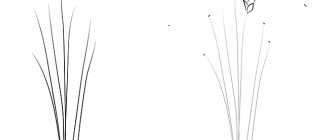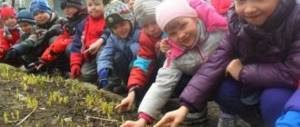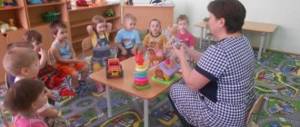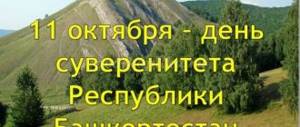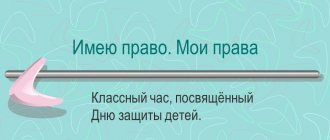Class hour “Bread is the head of everything”, 3rd grade
Class notes in elementary school on the topic “Bread is the head of everything”
Bread is a product of human labor, it is a symbol of well-being and prosperity.
It is bread that has the most important place on the table both on weekdays and on holidays. Not a single meal is complete without it. Many children do not know about the work of people who grow bread and treat bread carelessly (throw it, play with it, crumble it, make figures, throw away half-eaten pieces). A class lesson summary will help primary school teachers draw children’s attention to the efforts that make bread appear on our table, and instill a caring attitude towards bread. Before the event, preparatory work was carried out. Students prepared drawings on the topic, collected the necessary information, and learned proverbs. Parents organized an exhibition of bakery products. This event can be used as a lesson and as an extracurricular activity. Goal: - Expand existing knowledge about bread, its production, the importance of bread in human life. — To cultivate love, respect for bread, respect for working people, to whom we owe bread. Tasks: - Organizing joint work of students and teachers. — Involving students in basic mental operations, analysis, updating and systematization of acquired knowledge. — Development of logical and creative thinking. — Formation of the ability to work in a group. Course of the class hour I. Motivation He is famous first on earth, He is famous first on the table, The wind loves him, the steppes sway him. In front of the guests it lies in the steam room, Gray, white, black and rye. II. Creating a problematic situation A long time ago, it was when people lived in tribes in caves and ate animal meat. It so happened that they destroyed all the animals, and they had nothing to eat. So they went in search of other places where they could feed themselves. They walked for a long time, many died of hunger. This is what happened to one person. He fell, losing consciousness from hunger. When he woke up, there was no one around him. And suddenly, above him, he saw an amazing plant, from which small pebbles were falling on him. He decided to try one of them, and suddenly the pleasant smell and taste revived him. He began to collect these pebbles, which turned out to be grains, and eat them. These grains acted on him like medicine. He grew stronger and recovered, and he immediately wanted to tell people about it. He collected these grains and went to look for people. Seeing him alive and unharmed, people were surprised, and he told them about the miracle of the spikelet. I think everyone has guessed what we will talk about today? (about bread). We will learn a little about the history of its origin, try to understand the price of bread, learn about the work of the people thanks to whom this loaf is now on our table. -And let the words inspire us: “Bread is the head of everything!” III. Updating knowledge 1.Historical excursion Teacher: What do you know about bread? A word to historians. Student: The word “bread” first appeared in Ancient Greece. There they used specially shaped pots for baking – “klibanos”. It is consonant with our word “bread”. Bread has no price. Its value cannot be measured in money. It takes 1200 grains to bake just one loaf. Every day 82 thousand bread is baked in the country. There are more than 750 types of bakery products known in the world. Your friends will introduce us to interesting facts about the history of bread. Let's listen to them. 1st student According to scientists, the discovery of bread took place 16 thousand years ago and was invented by the Egyptians. It was then that man began to collect and cultivate cereals. True, at first, he ate grains in their natural form. Only later did Stone Age cooks learn to grind and mix grain with water. The first millstones, the first flour, the first bread appeared. Of course, it was not at all like the one we eat: the bread was liquid. 2nd student Later, when people mastered fire, they began to grind grains between stones and cook the resulting mixture. This liquid porridge was bread. Man learned to cultivate cereal plants about 5-6 thousand years ago. Around this same period, hand mills were created and the first baked bread appeared. 3rd student In Russia, since ancient times, baking bread was considered a responsible and honorable occupation. The production of rye bread required special skill. In addition to this, prosphyra and rolls of wheat flour were baked in the monastery bakeries. Bread came out of the monastery bakeries with the inscriptions: “Holy Bread”, “Almighty Bread”, “Eternal Bread”. Regardless of whether it was an ordinary meal or a festive one, when setting the table, the hostess first of all put bread and salt on it. Bread and salt were revered as a symbol of well-being and prosperity. In Ancient Rus', the townspeople of Ancient Rus' ate breads “unleavened”, “leavened”, “bread made with honey and poppy seeds”... Bread in Ancient Rus' has long symbolized people's well-being and contentment, and the people who made the bread were always held in high esteem. In Rus' they always took bread when going to get married. The hands of the newlyweds were placed on the bread when concluding a wedding agreement. Parents blessed their children for marriage not only with the icon, but also with bread. After the wedding, the newlyweds were greeted with bread and kvass; they began to greet them with salt much later. Then this bread was taken along with the bride's dowry. Bread was placed in the cradle of a newborn as a talisman. Teacher: We know how great the importance of bread is in people’s lives. What will happen if there is no bread? (children's discussion) That's right, a terrible time will come, which is called famine. And during the Second World War, bread was given out on ration cards. How expensive these cards were! Losing them is a tragedy, fear that there will be no more bread and you will die of starvation! In besieged Leningrad, 125 grams of bread per child were given per day. (showing a piece of bread 125 grams). The cruel enemy, having captured our lands, starved the people to break and defeat us. Without bread, there would be no great Victory, the 70th anniversary of which our country will celebrate this year. Yes, bread is holy and should be treated with care and respect. -Remember, at all times the attitude towards bread has been special and respectful. From time immemorial, people have treated with great respect the work of those who created it. 2. Application of theoretical knowledge in the conditions of completing the task Now we have to work in groups. One group is “Doctors”, the other is “Agronomists”. Each group will talk about bread. (children's performances). AGRONOMS - Do you know what cereals are? A cereal is a plant in the form of a hollow straw ending in spikelets or panicles. This family includes wheat and rye, barley and millet, oats, corn and rice. DOCTORS Bread provides our body with proteins, carbohydrates, and enriches it with magnesium, phosphorus, and potassium, which is necessary for brain function. Bread contains vitamins. Medical scientists believe that an adult eats 300–500 g of bread per day, and with hard work, all 700 g for children. Teenagers need 150–400 g of bread. A person gets almost half of his energy from bread. 3. Creative use of formed UUDs A) Working with proverbs - You and I have seen, guys, what a wealth this bread is! And it’s not for nothing that people have composed many proverbs and sayings about bread. And in St. Petersburg there is even a bread museum. At the beginning of the class hour, we decided that we would be accompanied by the words BREAD - EVERYONE'S HEAD! This is a Russian folk proverb. In Rus' they always treated bread with respect, so they came up with many proverbs. And on your tables you have cards with proverbs about bread. -We need to assemble a proverb from parts (the beginning is in bold), read it expressively to the whole class (we work in groups). We answer one by one. -Well done, remember these proverbs. If there is not a piece of bread, there is sadness in the mansion. Do you want to eat rolls -…. (don’t sit on the stove) Sow at the right time and you will have a mountain of bread. Bread in the bins means happiness in homes. Bread is father, water is mother. There were various signs associated with bread, with attitudes towards bread. • It was considered the greatest sin in Rus' to drop at least one crumb of bread, and an even greater sin was to trample this crumb underfoot. • People who break bread become friends for life. • It was not allowed for one person to finish eating bread after another - you would take away his happiness and strength. • You can’t eat behind another person’s back—you’ll also eat his power. • If you give bread from the table to dogs during a meal, poverty will befall you. 6) Crossword puzzle “Bakers” Dried piece of bread.
(Crusk.) Wheat bread made from choux pastry in the form of a ring. (Baranka.) Thick steering wheel. (Bagel.) Small, thin, very dry bagel. (Drying.) Sweet soft cookies in the form of a flat cake or flat figure. (Gingerbread.) A twisted bun, usually shaped like a figure eight. (Pretzel.) Buttery sweet cookie in the form of bread, loaf, usually with raisins. (Cupcake) White bread of oblong shape. (Loaf.) Bread made from wheat flour. (Bun.) A flatbread with curved edges and a curd top. (Cheesecake.) Download Crossword “Bakers”
IV. RESULT. REFLECTION - Our meeting is coming to an end. How will you and I remember it, what valuable things will you take away with you, has your attitude towards bread changed. Let's ask the bread ears to sum up the results.
We recommend watching:
Class notes for grades 3-4 for Victory Day Class notes for grades 3-4 “Colors of Nature” Class notes for elementary school on the topic “Give a Smile” Class notes for grade 3 on the topic “Motherland”
Similar articles:
Class hour about caring attitude towards people, 3rd grade
Class hour on the topic Health in 3rd grade
Class hour in 3rd grade on the topic “Human skin and its health”
Class hour for 2-3 grades. State and children's rights
Class hour for grades 3-4 on the topic “Fire does not forgive mistakes!”
Class hour “Bread is the head of everything”
Class hour “Bread is the head of everything”
4th grade
Target:
developing in students a moral position towards bread and the people who grow bread.
Tasks:
- systematize, deepen and expand children’s knowledge about bread
- instill the skills of economical and careful attitude towards bread
- cultivate respect and gratitude for the work of grain growers
- teach children to think, draw conclusions, analyze situations
- develop students' intelligence, quick thinking, speech, and attention. Activate children's speech and vocabulary.
- cultivate a sense of mutual assistance and understanding when working in small groups, communicative competence
Progress of the lesson
1. From the history of bread
.
Teacher:
We meet with him every day; neither a modest breakfast, nor an everyday lunch, nor a holiday table can be done without him. He accompanies us from birth to old age - our good friend, whose name is pronounced with love and warmth by people in all languages.
Who is this good friend of ours that we will talk about today? (children's answers)
Bread is always considered a symbol of well-being and prosperity; this food product is the most reliable means of protecting people from hunger.
Setting a goal
Today we will systematize and expand our knowledge about bread and the people who grow bread. To do this, we divided into groups. We will reflect, analyze, and draw conclusions. Be attentive, focused, help and support each other. We are learning to cooperate.
I invite the “Grain” group to tell interesting information from the history of bread.
From the history of bread
1st student:
How did bread appear on earth? This discovery is over 15 thousand years old. A long time ago, people simply ate raw grains, then learned to grind them between stones and mix them with water. The very first bread was in the form of liquid porridge. When people learned to make fire, they began to fry crushed grains with water. In ancient times, bread was highly revered; it was considered a separate dish.
2nd student:
In the Middle Ages, in many European countries, only members of the royal family could eat freshly baked bread. Yesterday's bread was intended for the king's entourage. Bread products baked two days ago were eaten by landowners and nobles. Three-day-old bread served as food for monks and schoolchildren. And peasants and small artisans fed on bread baked 4 days ago.
3rd student:
In Rus', baking bread was considered a responsible and honorable task. They baked bread with honey, poppy seeds, cottage cheese, kovrigi, pies, saiki, and rolls. Bakers were divided into bread makers, kalachniks, pirozhniks, gingerbread makers, and pancake makers. People spoke of bread as a living being: bread-breadwinner, bread-father. In Rus', bakers enjoyed special respect; they were called respectfully by their full names - Ivan, Fedor, Peter.
4th student:
Bread in Rus' was called “zhito”. The etymological dictionary indicates that it is formed from the word “zhiti” (to live) and the suffix “to.” There is only one word equivalent to bread. This word is life.
Teacher:
At all times, bread has been and remains a product that can feed a person in the darkest time of life. They took care of bread, and in honor of bread they composed hymns, songs, riddles, and proverbs. Guests were greeted with bread and salt.
2. How bread is grown.
Teacher:
How did bread come to our table? What journey did he take? The Kolosok group will tell us about this.
2nd student:
Why are the sides of the pie browned?
The snow will melt in a clean field, the melt water will subside, it will run after the tractor driver in the early morning furrow.
Then the seeders will come out to sow the fields with grain. And black as from an oven, Rooks see them off.
So that the seedlings are stronger, the evil aphid does not attack, and the pilot will fertilize and heal the field from the air.
You can hear the hum of combines by the river in the summer until sunset, And trucks are transporting Harvest to the grain elevator.
The bread was harvested - and it became quiet, the mills were grinding the grain. The pole-field is tired, And it sleeps under the snow.
Smoke floats over the village: Pies are being baked in the houses. Why are the sides of the pie browned?
Because the field in summer was warmed by the sun. Because on a spring day, a summer day, an autumn day, we all warm the earth with both love and labor!
Teacher:
Yes, how much work needs to be put in for a small grain to become bread, a bun, a pie, a loaf.
Representatives of what professions can you name who worked on the creation of bread? (agronomist, grain grower, combine operator, miller)
. Representatives of more than 100 professions are working on this.
“It’s not a big piece of the pie, but it costs a lot of work,” as the proverb goes.
What proverbs about bread do you know?
- Bread is the head of everything.
- Bread is father, water is mother.
- I'm rolling some bread, grandpa.
- A bad lunch when there is no bread.
- Not a piece of bread - and there is melancholy in the upper room.
- Bread and water is a man's food.
- Bread is bread brother.
- The chicken pecks one grain at a time and lives until it is full.
- What goes around comes around.
- Labor feeds a person, but laziness spoils him.
Teacher:
Explain how you understand the meaning of these proverbs?
Bread... Will it get boring? Never! Don’t even try to do without it, without it a person will be in trouble. Bread contains a lot of nutrients - proteins, fats, carbohydrates, mineral salts, vitamins. Medical scientists have calculated that an adult eats about 500 g of bread per day, and 800 g during hard work. Bread contains up to 7% protein, 45% carbohydrates, providing a person with 1000-1600 kcal of energy daily. This means that a person receives almost half of the energy resources necessary for life from bread.
3. The theme of bread in art.
The theme of bread is reflected in the works of many outstanding artists, composers, and writers (reproduction of Shishkin’s “Rye”, music by M. Blanter “Golden Wheat”).
Teacher:
What is your mood, what feelings did you experience while looking at the reproduction?
This is one of the artist's best works. It brought Shishkin well-deserved fame. The artist depicted the wide expanses of a rye field. As far as the eye can see, a golden sea of ripening ears stretches out to the very horizon, rippling with the wind. They approached the road in a dense wall, going into the distance. Mighty giant pines rise above the rye field, as if guarding this untold wealth. Summer heat foreshadows a thunderstorm. Storm clouds are creeping in. The painting “Rye” is a generalized image of the Motherland.
It victoriously sounds a solemn hymn to the fertility and majestic beauty of the Russian land.
The guys did their best, presented their creativity, composed fairy tales, poems, and stories about bread.
4. Work in groups.
Teacher:
The “Bakers” group prepared riddles “What can’t you bake bread without?”
What can't you bake bread without?
– Born in water, but afraid of water (salt)
.
- I am a cloud, and fog, and a stream, and an ocean, And I fly, and I run, and I can become glass (water)
.
- I’m white as snow, in everyone’s honor, And you like me, but it’s harmful to my teeth (sugar).
- Liquid, not water, sweet, not honey, They take it from Buryonushka and give it to the children (milk).
- The hot old lady stands in one place, And you can’t move her (stove) from corner to corner.
- Bela Belyana, she walked across the field, came home, lay down in the bottom (flour).
- He is golden and mustachioed, in a hundred pockets there are a hundred guys (ear of ears).
- Everyone needs it, but not everyone will make (bread).
- It’s both lumpy and spongy, and soft and brittle, but the cutest of all (bread).
- A giant ship does not sail on the sea, a giant ship travels on land. The field will pass and the harvest will be reaped. (harvester)
– Grew up in a field as a spikelet, lies on the table in a piece (of bread)
.
5. Quiz on fairy tales.
• I sweep the barn, I scrape the bottom ends, mix it with sour cream, plant it in the stove, freeze it on the window. (“Kolobok”, Russian folk tale)
• Stove, mother, hide me! Eat my rye pie, then I’ll hide it. The girl quickly ate the rye pie and climbed into the oven. The geese flew past. (“Geese-swans”, Russian folk tale)
• She put the prince to bed, and she herself turned into a maiden soul, Vasilisa the Wise, went out onto the porch and shouted in a loud voice: “Mother-nannies, get ready, get ready! Prepare soft white bread, the kind I ate at my dear father’s.” (“The Frog Princess,” Russian folk tale)
• A bear walks between the fir trees, a bear wanders between the birch trees, he is tired and decides to rest. I’ll sit on a tree stump and eat a pie. (“Masha and the Bear”, Russian folk tale)
• The brothers planted wheat and transported it to the capital city. Someone began to walk in the field and stir the wheat. (“The Little Humpbacked Horse” by P.P. Ershov)
• – Once upon a time there lived two mice, Krut and Vert. Yes cockerel Vocal throat. One day the cockerel was sweeping the yard and saw a spike of wheat on the ground. (“Spikelet”, Ukrainian folk tale)
• “Go to grandma, bring her this pie and a pot of butter.” (Charles Perrault "Little Red Riding Hood")
• “Where did the bread come from in the forest? Zinochka carefully tried it and began to eat. She ate all the black bread clean and praised it. Chanterelle bread is much better than ours. (“Fox Bread” by M.M. Prishvin)
• Thank you for bringing me the pie. It's been a long time since I've eaten anything hot. I covered the young greenery with a snow feather bed. Spring will come - the snow feather bed will melt, the grass will sprout. And there the grain will appear. And the peasant will take the grain and take it to the mill. The miller will grind the grain, and there will be flour. And you, needlewoman, will bake bread from flour. (V.F. Odoevsky “Moroz Ivanovich”)
6. Competitions
Teacher:
Buns, bagels, pies – we love them all. Now let’s find out how grateful you are.
Who can choose the most words of praise for the bun?
Tasty, fragrant, sweet, aromatic, appetizing, sugary, rosy, rich, fresh.
8. Conclusion
Teacher:
Our extracurricular activity is coming to an end. Let's collect every single crumb and not leave a single uneaten piece. And now we will hear important information from the “Kroshki” group.
1) One grain produces about 20 mg of flour. This means that baking one loaf requires flour from grinding 10,000 grains!(!)
2) Every school in our country throws away 20-25 kg of bread every day. This is the price of uneaten pieces. Every schoolchild must firmly understand: take a piece of bread in the cafeteria - eat it! Don't you want to eat?! Do not take!!!
3) The guys from one village carried out a calculation: if each person doesn’t eat enough and throws away 50 g of bread in one day, this will amount to 200 kg, i.e. about 200 loaves of bread will be thrown away. Bread is a treasure. Don't bother them. Take bread in moderation for lunch.
Teacher:
Do you know how to keep bread fresh for as long as possible? Black and white bread should be stored separately. This way it doesn’t go stale or mold longer.
In order to “refresh” stale bread, you need to sprinkle it with water or cover it with a damp cloth for 2-3 minutes, then place it in a preheated oven. You can make crackers and croutons from stale bread.
We will always remember the people who grow wheat, make flour from grains, and make bread, buns, and confectionery from flour, and we will bow low to them. We end our celebration with these words:
1st student:
Here it is - a fragrant bread, with a crunch, a twisted crust. Here it is, warm and golden! As if bathed in sunshine!
In it is health, our strength, in it is a wonderful warmth, in it is the juice of the native land, in it is the light of spring in the sun.
How many hands raised him, protected him, took care of him! It smells like a field, a river, an oven, the sky. And most importantly, the bread smells of work.
After all, the grains did not immediately become the bread that is on the table. People worked long and hard on the earth.
2nd student:
The people have words, Bread is the head of all life, Bread does not fall from the sky for us, It does not appear suddenly, For an ear of bread to grow, the work of a dozen hands is needed.
Glory to peace on earth! Glory to the bread on the table! Glory to those who grew bread, Spared no labor and effort!
Bottom line.
– What feelings did you experience during the lesson?
– Has your attitude towards bread changed?
The topic of bread is inexhaustible. It is not limited to just extracurricular activities. We have already touched on this topic in reading and Russian language lessons, and we will encounter it more than once both at school and in life.
